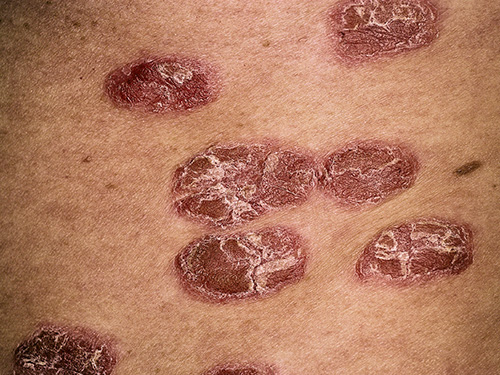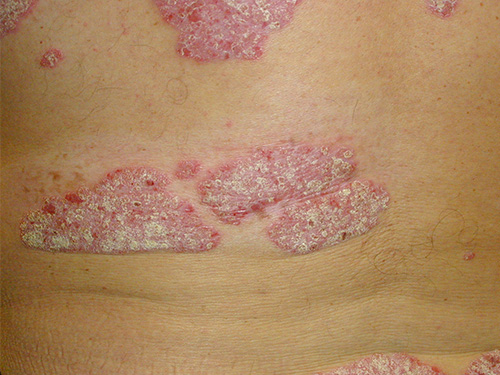Presentation of psoriasis
Psoriasis is a chronic inflammatory and hyperproliferative condition of the skin, characterised by erythema and scale. It ranges from a few plaques to widespread inflammation with pustules and systemic symptoms. The course of psoriasis is often difficult to predict because severity can fluctuate with periods of remission and flares.
Plaque psoriasis is the most common type of psoriasis. Less common types of psoriasis include guttate psoriasis, generalised pustular psoriasis and erythrodermic psoriasis.
Lesions in plaque psoriasis are symmetrical, well circumscribed, salmon pink, with a loose silvery scale—they may be single or numerous. For a photo of typical plaque psoriasis lesions, see here.

Reproduced with permission from the A-Z of Skin [digital]. Australasian College of Dermatologists. Sydney. https://www.dermcoll.edu.au/

Photo sourced with permission from Dr Jonathan Chan.
Psoriasis can affect the scalp, trunk and limbs, palms and soles, nails, flexures (including genitals) and face. Common sites are the elbows, knees, lower back, sacrum and scalp. For photos and detail on presentation of psoriasis in different body areas, see Plaque psoriasis treatment according to location.
Psoriasis may present at any age with two main peaks of onset: a larger peak ranging from the late teenage years to mid-20s (up to 30 years old), and a smaller peak around 50 to 60 years oldArmstrong, 2017Langley, 2005. It is uncommon in children, but psoriasis often presents as severe cradle cap or stubborn nappy rash in infants. See also Napkin psoriasis.
Patients with psoriasis can develop arthritis; however, only a minority have psoriatic arthritis. Patients with psoriasis of the nails are more likely to have psoriatic arthritis in the hands. Having scalp psoriasis increases the likelihood of axial spondyloarthritis—like all spondyloarthropathies, this increases the risk of uveitis.
Some evidence suggests that psoriasis is an independent risk factor for cardiovascular diseaseMosca, 2015. However, patients with psoriasis often have other risk factors that may further increase the risk of cardiovascular disease, such as obesity with metabolic syndromeFleming, 2015 and smoking. Some evidence suggests a significant association between psoriasis (eg palmoplantar psoriasis [psoriasis of the hands or soles]) and smokingOlazagasti, 2017Richer, 2016.
